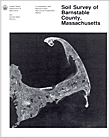The following is a map unit description from the "Soil Survey of Barnstable County, Massachusetts (Fletcher, 1993)"

HnB-Hinesburg sandy loam, 3 to 8 percent slopes. This very deep, gently sloping, well drained soil is in undulating areas and on low hills in areas of glacial lake plains. It makes up about 0.1 percent (386 acres) of the survey area. It is mapped mainly in the PlymouthEastchop-Carver-Boxford general soil map unit. Areas are irregular in shape and range from 5 to 75 acres in size.
Typically, the surface layer is dark brown, very friable sandy loam about 10 inches thick. The subsoil is about 22 inches thick. The upper 12 inches is yellowish brown, very friable loamy coarse sand, and the lower 10 inches is light olive brown, very friable loamy sand. The substratum extends to a depth of 65 inches or more. It is mottled. It is light brownish gray, friable fine sandy loam in the upper 6 inches and light olive brown, firm sandy clay loam in the lower part.
Included with this soil in mapping are small areas of Amostown, Carver, and Plymouth soils and areas where slopes are less than 3 percent or more than 8 percent. Also included are areas where the soil is underlain by sandy and gravelly material below a depth of 65 inches. Included soils make up about 30 percent of this unit.
Permeability is rapid in the subsoil of the Hinesburg soil and moderately slow in the substratum. Available water capacity is moderate. Depth to the seasonal high water table is generally more than 6 feet. In some areas, however, a perched water table is above the loamy and silty substratum in late fall, in winter and spring, and after periods of heavy precipitation.
Most areas are used as woodland. Some areas have been developed for homesites, and a few areas are farmed.
This soil is well suited to cultivated crops. Good tilth can be easily maintained. Erosion is a management concern. Farming on the contour or across the slope, terracing, stripcropping, including grasses and legumes in the crop rotation, growing cover crops, and applying a system of conservation tillage help to control runoff and erosion. Mixing crop residue and manure into the surface layer helps to maintain good tilth and increases the organic matter content and the available water capacity.
This soil is well suited to hay and pasture. The main management concern is the prevention of overgrazing, which reduces the hardiness and density of desirable plants. Proper stocking rates, timely grazing, and restricted use during wet periods help to maintain plant density and minimize surface compaction.
This soil is fairly well suited to woodland. Minimizing surface disturbance helps to retain a spongelike mulch of leaves, which absorb precipitation and help to maintain the limited moisture supply. Removal or control of competing vegetation helps to obtain the best growth of newly established seedlings. The most common trees are pitch pine, white oak, scarlet oak, and eastern white pine.
In areas where this soil has a seasonal high water table, wetness is a limitation on sites for dwellings with basements and on sites for septic tank absorption fields. The moderately slow permeability in the substratum also is a limitation on sites for septic tank absorption fields. Additions of fill or a regional drainage system helps to overcome the wetness. Enlarging the absorption fields helps to overcome the restricted permeability. In areas where the soil is underlain by sandy and gravelly material, excavations that extend to this material generally can overcome the wetness and slow permeability.